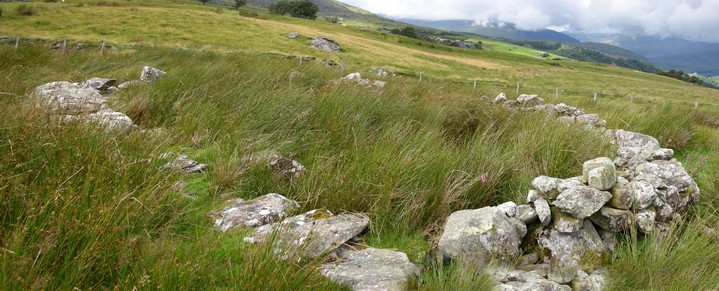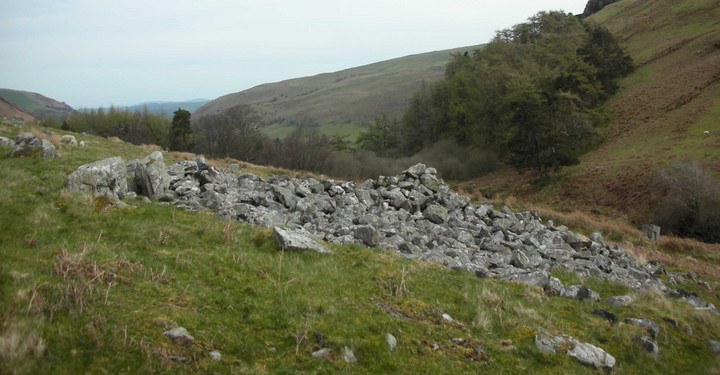





Chocolate lab for size reference.
This Dolmen is further down the track than Postman’s directions suggest. It’s almost a mile from the tarmac road to where the footpath forks. At the fork (after a makeshift gate and fence) turn left and enjoy the view...
Copy of tweet submitted by Rhys Mwyn @therealrhysmwyn on the 30/05/14:
No words can express my anger at the idiots that have damaged Bryn Cader Faner by erecting a stone in the middle.

An image of the damage caused to Bryn Cader Faner by some idiot deciding to erect a stone in the middle!


Looking North, very easy to find, a short walk from the source of the River Severn.
A very round cairn mostly grassed over. There are a few indentations in the centre that could be the result of collapsed cists.
The stone in the foreground could be an outlier.
Cadw lists it as being religious, ritual and funerary, but also tells us that it known locally as ‘The Cock Pit’, could this be a later development/use of a convenient small round enclosure?

A very round cairn mostly grassed over. There are a few indentations in the centre that could be the result of collapsed cists.
Cadw lists it as being religious, ritual and funerary, but also tells us that it known locally as ‘The Cock Pit’, could this be a later development/use of a convenient small round enclosure?

The more obvious of the three Round Barrows at the top of Tarrenhendre. Awesome panoramic views from here!

With a dog for scale. The angular position of the kerb stones reminds me of Bryn Cader Faner.



Article in the ‘Craven Herald & Pioneer’- March 23 2009
Modern cairns built by Dales hikers will be dismantled this weekend under plans to preserve a Bronze Age chieftain’s burial site.
The Yorkshire Dales National Park Authority has organised the initiative after expressing fears that walkers have unwittingly used rocks from the ancient burial mound to build new landmarks.
Now local archaeologist Yvonne Luke and Dales volunteers plan to dismantle the cairns and all but one of the windbreaks at Beamsley Beacon, near Bolton Abbey.
Robert White, senior conservation officer for the Yorkshire Dales National Park Authority, said: “There are problems at a number of historically-important sites in the national park, including Beamsley Beacon.
“During the Bronze Age, some 4,500 years ago, a large stone mound was built there, probably to mark the burial place of a local chieftain and as a boundary marker. “Much of this cairn, now about 11 metres in diameter, still survives, but in recent years it has suffered a lot of disturbance due to people using stones from it to make modern cairns and windbreaks. Another smaller historic cairn lies further along the ridge at Old Pike and that has also lost some of its stones.
“We would urge walkers to resist the temptation to pick up stones and build cairns – wherever they are – because they can unwittingly damage ancient, historically-important sites like this stone mound.”
Walkers have always appreciated the good views at Beamsley Beacon. Its name, recorded in 1667, suggests it was used as part of a signalling system using fires. In 1804, during the Napoleonic wars, the beacon was refurbished and a guardhouse was constructed to shelter the beacon keeper.
Unfortunately, the stone foundations of this building are also suffering from modern stone moving.
A temporary poster urging people not to build cairns and explaining why will be put up on the concrete triangulation point and will eventually be replaced by a permanent interpretation panel.
A detailed archaeological survey of the hilltop has been done and Mr White and his team are appealing for old photographs of the site.
Contact Mr White or members of the Historic Environment Team on 0300 456 0030.
cravenherald.co.uk/news/4213677.___Don___t_desecrate_the_chieftain___s_grave___/

The original cairns dimensions can just be made out in this photo.
“The cairn is situated on level ground near the head of the Egnant valley at a point where the land begins to fall away fairly steeply down valley to the SW. A mountain pathway passes close by.
The cairn consists of a low mound of mixed grade stones for the most part consolidated with grasses and mosses. The E half of the cairn contains a large proportion of loose rubble. Overall it measures 7.8m (N-S) by 7.3m with a maximum height of 0.35m. The cairn appears to be more-or-less intact and there is no structure visible. The cairn contains a signifcant amount of quartz.”
Above is the site description from the RCAHMW website. It was last visited by them on the 29 April 1984.
As is painfully obvious some idiot has used this cairn to create a marker cairn for walkers at the head of the valley! The remains of the original burial cairn are still visible below the pile of stones.
There is a second ring cairn called Graig Wen very close to the north east of this cairn but I was unable to find it this time. At least it’s not been converted into a sheep enclosure!

“The cairn is situated on level ground near the head of the Egnant valley at a point where the land begins to fall away fairly steeply down valley to the SW. A mountain pathway passes close by.
The cairn consists of a low mound of mixed grade stones for the most part consolidated with grasses and mosses. The E half of the cairn contains a large proportion of loose rubble. Overall it measures 7.8m (N-S) by 7.3m with a maximum height of 0.35m. The cairn appears to be more-or-less intact and there is no structure visible. The cairn contains a signifcant amount of quartz.”
Above is the site description from the RCAHMW website. It was last visited by them on the 29 April 1984.
As is painfully obvious some idiot has used this cairn to create a marker cairn for walkers at the head of the valley! The remains of the original burial cairn are still visible below the pile of stones.
There is a second ring cairn called Graig Wen very close to the north east of this cairn but I was unable to find it this time. At least it’s not been converted into a sheep enclosure!

A Welsh web site that has grown out of the publication of the very popular book ‘Meini Meirionnydd’. The site is currently under development but will eventually have information in Welsh about the Pre-history monuments of Wales.

The town of Dolgellau can just be seen in the top left hand corner of this picture.

Small site concentrating on prehistoric sites in Wales. Information on each site is provided in both Welsh and English.


This cairn looks as though it may have been modified over the years, although on closer inspection there is a lot of cairn material in the long grass.


This cairn appears to be on the same alignment as the Carneddau Hengwm cairns (a couple of miles to the south). This has been plundered to a much greater extent than either of the Carneddau Hengwm cairns probably due to its proximity to the track.

Looking towards the Great Carnedd from Llecheiddior Cairn

The ‘legs’ of the recumbent ‘earth mother’ are just visible from this angle – and I agree, that ‘bloody pylon’ is far too close!



Not just a massive monolith but wonderful colours too!


Looking northwest with the capstone and the only visible kerbstone.

Looking roughly northwest with the cist in the foreground

Taken from the other side of the Afon Disgynfa with the cairn at the foot of Moel Sych



May be a ring cairn behind the stone to the left??

Looking north west towards the Afon Conwy




With Annette on a cold misty morning – very atmospheric!
